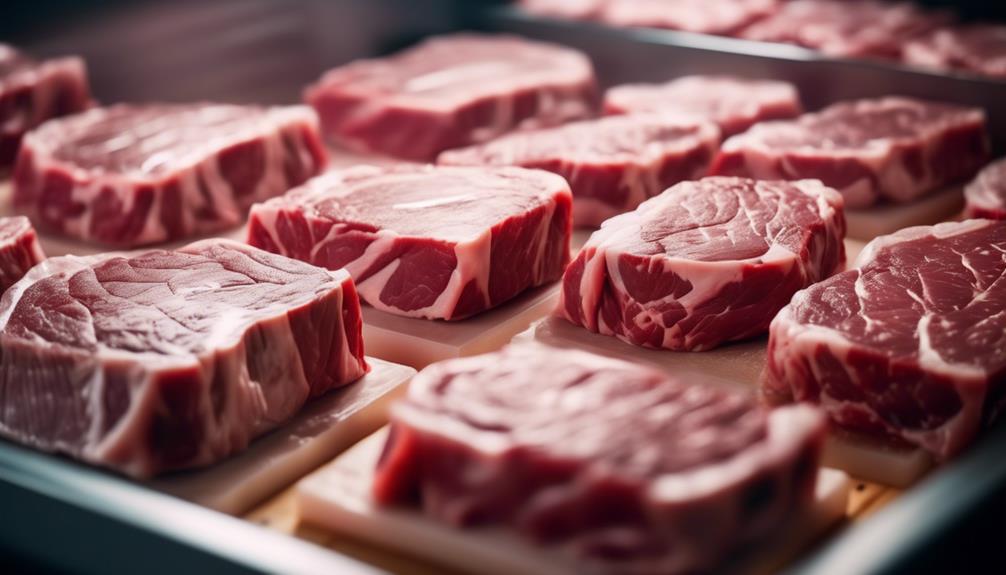Freezing meat is like preparing for a long winter hibernation; you need to ensure it's done right to maintain quality and flavor. When you select your cuts of meat, look for freshness and minimal processing, as these factors greatly influence how well the meat withstands freezing.
You'll want to store each piece properly – that means tightly wrapping the meat to prevent freezer burn and flavor loss. It's essential to use materials specifically designed for freezing, such as heavy-duty aluminum foil, freezer paper, or plastic freezer bags, and make sure you expel as much air as possible before sealing.
Labeling each package with the date and type of meat will help you keep track of your inventory. And while these steps might seem straightforward, there's a technique to mastering the perfect freeze, one that maintains the integrity of your meat so that when it's time to thaw, it's as good as the day you bought it.
Stay tuned to uncover the key strategies that will elevate your freezing game and keep your meat in top-notch condition for those future hearty meals.
Key Takeaways
- Choose fresh cuts with no discoloration or unpleasant odors
- Wrap each piece individually to avoid unnecessary defrosting
- Label each package with type of meat, date of freezing, and weight/serving size
- Thaw in the refrigerator for safe and slow thawing
Selecting Meat for Freezing
When choosing meat to freeze, opt for fresh cuts that show no signs of discoloration or unpleasant odors to ensure the best quality after thawing. Meat quality is paramount when it comes to freezing, as the process can magnify any existing issues. Seek out a reputable butcher's advice if you're unsure about a cut's freshness. They can guide you on what to look for and which cuts freeze best.
Fresh meat should be firm to the touch, with a bright color that's typical for the type of meat you're selecting. For beef, a cherry-red hue is a good indicator, while pork should be more of a blush pink. Chicken ought to have a consistent creamy color without any grayish tones. Always check the sell-by date if you're buying packaged meat, but remember that your senses are your best tool. If it doesn't look, feel, or smell right, it's better to pass it up.
Once you've selected your meat, prepare it for freezing as soon as possible. Freezing meat quickly after purchase preserves its quality and reduces the risk of bacterial growth. By following these guidelines, you'll have high-quality meat ready for your future meals.
Preparing Meat for Storage
Before freezing your selected cuts, it's crucial to properly wrap and protect the meat to prevent freezer burn and maintain its quality. You'll want to remove as much air as possible, which can cause dehydration and oxidation over time.
To do this, first pat the meat dry with paper towels. If you're using meat marinades, now's the time to add your flavor. Marinate in the refrigerator and then drain any excess liquid before freezing; this helps in retaining taste and tenderness.
Butcher's advice often includes wrapping each piece of meat individually. This way, you're not forced to defrost more than you need at one time. Use heavy-duty aluminum foil, plastic wrap, or freezer paper for this task. Ensure it's wrapped tightly, pressing the wrapping material against the surface of the meat to exclude air.
For an extra layer of protection, place the wrapped meat in a resealable freezer bag. Squeeze out any remaining air and seal the bag. Label each package with the date and type of meat.
Proper Wrapping Techniques
Having covered the initial preparation, let's focus on the specifics of wrapping meat effectively to ensure its longevity in the freezer. Proper wrapping is essential to prevent freezer burn and maintain the quality of your meat. Vacuum sealing is the gold standard for this task, as it removes air, creating a tight moisture barrier that keeps your meat fresh longer.
Here are the key steps to wrap your meat properly:
- Choose the Right Materials: Select a heavy-duty aluminum foil, freezer paper, or plastic wrap that's designed for freezing.
- Wrap Tightly: Press the wrapping material firmly against the surface of the meat to eliminate air pockets.
- Double Layer: For added protection, double wrap your meat or place the first wrapped layer into a freezer bag.
- Label Clearly: Use a permanent marker to note the contents and the date of freezing.
- Vacuum Seal if Possible: If you have a vacuum sealer, use it to provide the best moisture barrier and prevent air from getting in.
Wrapping meat correctly is a practical step you can't skip if you want to enjoy flavorful, tender meat even months after freezing. Master these techniques, and you'll make the most of your freezer space and budget.
Freezing and Organizing Tips
To maximize your freezer efficiency and maintain the quality of your frozen meats, it's important to organize them systematically after wrapping.
Begin by selecting the right storage containers. These can include heavy-duty freezer bags, airtight plastic containers, or aluminum foil pans with lids. Make sure they're suitable for freezing and won't crack at low temperatures.
Once you've chosen your containers, arrange them in your freezer in a way that lets you utilize the available space effectively. Place larger or heavier items at the bottom and stack lighter ones on top. This not only helps in maintaining the structure but also prevents any crushing of delicate meats.
It's also crucial to label each package clearly. Use inventory labels that can withstand cold temperatures without peeling off. Write down the type of meat, the date of freezing, and the weight or serving size. This makes it easier for you to find what you need without having to thaw anything unnecessarily, and it helps in rotating your stock to use the oldest items first.
Thawing Frozen Meat Safely
Once your meat is properly organized and frozen, it's crucial to learn how to thaw it safely to prevent any risk of foodborne illnesses. Understanding the right thawing methods not only ensures safety but also maintains the quality of your meat. Here's what you need to know about safe defrosting:
- Refrigerator Thawing: Transfer the meat from the freezer to the fridge and let it thaw slowly. It's the safest method, but it requires planning ahead, as it can take up to 24 hours.
- Cold Water Thawing: Place the meat in a leak-proof bag and submerge it in cold water, changing the water every 30 minutes to ensure consistent thawing.
- Microwave Thawing: Use the defrost function on your microwave for a quick thaw. However, cook the meat immediately after defrosting as some areas may begin to cook during the process.
- Cooking Without Thawing: It's safe to cook frozen meat directly from the freezer, but expect the cooking time to be about 50% longer than if the meat were thawed.
- Never Thaw at Room Temperature: Thawing meat on the counter can allow bacteria to grow at an unsafe rate.

